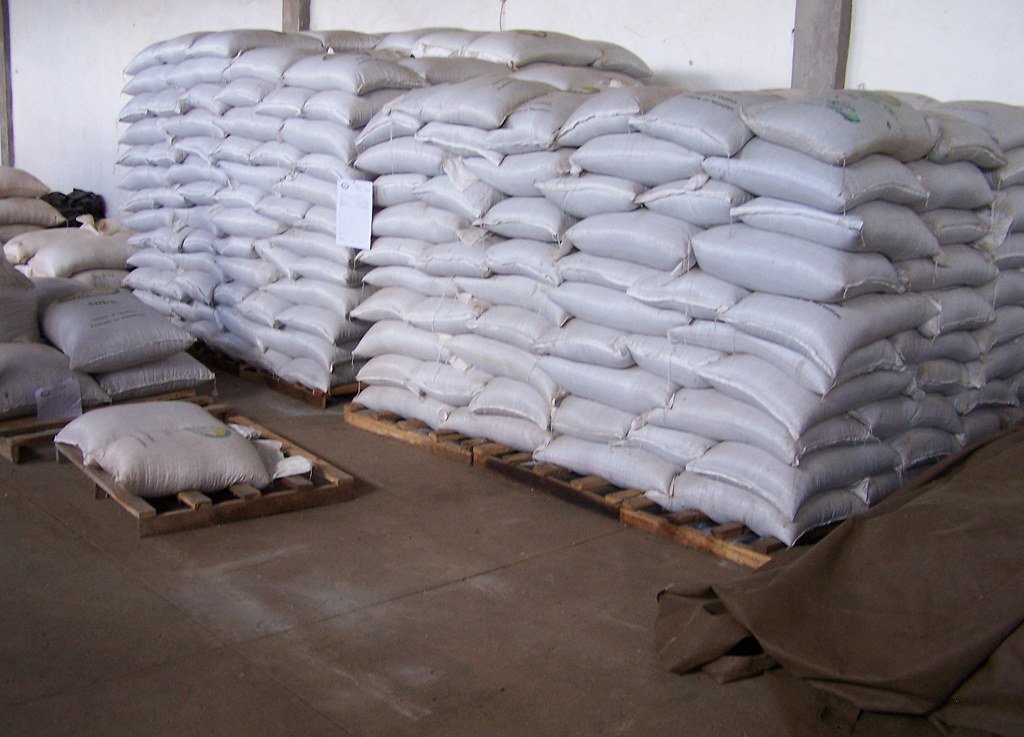Now Reading: How to Store Grains for the Long Haul
-
01
How to Store Grains for the Long Haul

How to Store Grains for the Long Haul
How to Store Grains for the Long Haul
In a world filled with uncertainties and ever-changing circumstances, ensuring a stable supply of food has become an increasingly pressing concern for individuals and communities alike. Whether you are an eager homesteader, a prepper preparing for the unknown, or simply someone seeking to reduce food waste, understanding the art of grain storage can prove to be invaluable. As ancient as civilization itself, the practice of storing grains has evolved significantly, offering us ingenious techniques that have stood the test of time. Join us on a journey to discover the secrets of long-term grain preservation, unearthing the wisdom of our ancestors, and unlocking the potential to secure sustenance that will sustain generations to come.
Table of Contents
- The Importance of Proper Storage for Long-Term Grain Preservation
- Key Factors to Consider When Storing Grains for Extended Periods
- Effective Techniques for Maintaining Grain Quality Over Time
- Essential Tips for Maximizing Shelf Life of Stored Grains
- Recommended Storage Containers and Conditions for Long-Term Grain Maintenance
- Q&A
- The Conclusion

The Importance of Proper Storage for Long-Term Grain Preservation
Grain preservation is a critical aspect of agriculture and food security. When it comes to storing grains for the long term, proper storage techniques are vital to maintain the quality and nutritional value of the harvest. Let’s delve into the reasons why investing in the right storage solutions is crucial for farmers and consumers alike.
1. Preventing Spoilage:
Proper storage conditions play a key role in avoiding spoilage caused by pests, moisture, and temperature variations. Airtight containers or silos provide a protective environment from external factors, minimizing the risk of mold, insects, or rodents infiltrating and damaging the stored grains. It is essential to keep grains dry, cool, and well-ventilated to preserve their freshness and prevent rapid deterioration.
2. Maintaining Nutritional Value:
Grains are a valuable source of nutrients, fiber, and energy. However, without appropriate storage, these vital elements can quickly degrade. High temperatures, prolonged exposure to light, and unsuitable humidity levels accelerate nutrient loss, affecting the quality of the grains. By implementing proper storage techniques, such as using dark, cool spaces and moisture-resistant containers, farmers can help retain the nutritional integrity of their produce, ensuring consumers receive grain products with optimal health benefits.
3. Minimizing Economic Losses:
Poor grain storage practices can lead to significant economic losses for farmers. Inadequate storage facilities can result in spoilage, reducing the quantity available for sale and increasing waste. Moreover, damaged or spoiled grains may fetch lower prices in the market, resulting in financial setbacks for agricultural communities. By prioritizing proper storage methods, farmers can mitigate these risks, maximize their harvest yields, and secure profitable returns.
Beyond the immediate benefits, proper grain storage also contributes to long-term food security. With the world’s growing population, ensuring the availability of high-quality grains is essential for sustaining global food supplies. By acknowledging the importance of proper storage techniques and investing in suitable infrastructure, stakeholders can work together to minimize food loss, support sustainable agriculture, and safeguard nourishment for generations to come.

Key Factors to Consider When Storing Grains for Extended Periods
Ensuring the longevity and quality of stored grains is essential for any agricultural enterprise or household. Whether you’re stockpiling for emergencies or storing surplus produce, here are some crucial factors to keep in mind:
- Proper Containment: Choose suitable containers that are airtight and moisture-resistant. This helps prevent spoilage, insect infestation, and moisture damage. Consider using food-grade plastic buckets with tight-sealing lids or sturdy metal bins.
- Optimal Temperature: Grains should be stored in a cool, dry place with stable temperatures. Heat accelerates the enzymatic processes that cause spoilage, while fluctuating temperatures can promote condensation and mold growth. Aim for temperatures below 70 degrees Fahrenheit (21 degrees Celsius) to maintain grain quality.
- Absence of Light: Exposure to light can lead to vitamin degradation and discoloration of grains. Store them in a dark environment or use opaque containers to protect their quality.
- Regular Inspection and Rotation: Even when stored under ideal conditions, grains can deteriorate over time. Regularly inspect your stored grains for signs of spoilage, pests, or moisture. Additionally, practice the first-in, first-out (FIFO) method to ensure older grains are used first, minimizing any potential losses.
- Pest Prevention: Pests such as weevils, moths, and rodents can wreak havoc on stored grains. To avoid infestations, consider using airtight containers, storing grains off the ground on pallets, and employing preventive measures like diatomaceous earth or bay leaves.
Remember, proper storage practices are essential to maintain the nutritional value, flavor, and longevity of your stored grains. By following these key factors, you can ensure a bountiful and reliable supply of grains for extended periods.

Effective Techniques for Maintaining Grain Quality Over Time
In order to ensure the long-term quality of your grains, it is essential to employ a variety of techniques that promote freshness and prevent spoilage. These effective methods can help you preserve the nutritional value and flavor of your grains, ensuring that they remain in optimal condition for an extended period of time.
Proper Storage:
- Keep your grains in airtight containers to prevent exposure to moisture and pests.
- Store grain containers in a cool, dry place to minimize the risk of mold or bacterial growth.
- Avoid direct sunlight, as it can accelerate spoilage and decrease freshness.
Regular Inspection:
- Periodically check your grains for signs of infestation or spoilage, such as unusual odors or discoloration.
- Discard any damaged or compromised grains to prevent contamination of the entire storage.
- Inspect storage areas for any potential leaks or areas of excessive humidity that could harm the quality of your grains.
Rotation:
In order to maintain grain quality, implement a first-in, first-out (FIFO) system. This approach ensures that older grain is used or discarded before fresher supplies. By consistently rotating your stock, you can minimize the chances of spoilage and optimize the nutritional value of your grains.
By following these effective techniques, you can significantly improve the longevity and quality of your stored grains. Implementing proper storage, regular inspection, and rotational practices will allow you to savor the freshness and nutritional benefits of your grains over an extended period of time.

Essential Tips for Maximizing Shelf Life of Stored Grains
When it comes to storing grains for the long term, there are several essential tips that can help you maximize their shelf life and maintain their quality. Whether you are stocking up on grains for emergency preparedness or simply looking to extend the lifespan of your pantry staples, these tips will ensure that your stored grains stay fresh and nutritious for as long as possible.
First and foremost, proper storage containers are crucial for preserving the quality of your grains. Opt for airtight containers made of food-grade materials such as glass jars or plastic containers with tight-fitting lids. These containers will prevent moisture and pests from infiltrating your grains, keeping them dry and free from contamination.
Additionally, it’s important to store your grains in a cool and dark location. Exposure to heat, light, and humidity can accelerate the deterioration process and diminish the nutritional value of your grains. Choose a pantry or basement area that is away from direct sunlight and has a relatively stable temperature.
To further maximize the shelf life of your stored grains, consider implementing a few extra precautions:
- Rotate your stock: Use the “first in, first out” (FIFO) method to ensure that older grains are consumed before newly purchased ones. This helps to avoid spoilage and guarantee that your stocks remain fresh.
- Inspect for signs of spoilage: Regularly check your stored grains for any signs of insects, mold, or unusual odors. If you detect any, discard the affected grains immediately to prevent contamination.
- Consider freezing or oxygen absorbers: For long-term storage, you may want to freeze your grains in sealed bags or use oxygen absorbers to remove excess air from the containers. This technique can help extend the shelf life of your grains even further.
By following these essential tips, you can maximize the shelf life of your stored grains and ensure that they remain fresh, nutritious, and ready to be used whenever you need them. With proper storage and care, your pantry staples will be there to serve you in times of need or simply as a delicious addition to your everyday meals.
Recommended Storage Containers and Conditions for Long-Term Grain Maintenance
When it comes to preserving your grains for the long term, choosing the right storage containers and maintaining optimal conditions is crucial. By following these recommendations, you can ensure that your precious grains stay fresh and retain their quality for extended periods:
- Choose airtight containers: Opt for containers with tight-fitting lids that create a seal, preventing moisture and pests from infiltrating the grains. Mason jars, food-grade plastic buckets, and metal canisters with rubber gaskets are excellent options.
- Consider dark or opaque containers: Exposure to light can cause grain deterioration over time. To protect against this, select containers that are opaque or dark-tinted. This shields your grains from harmful UV rays and helps maintain their nutritional value.
- Maintain temperature and humidity: Store your grains in a cool and dry environment to prevent spoilage. Ideally, the temperature should be below 75°F (24°C) to inhibit mold growth, while the humidity level should remain below 15% to prevent moisture accumulation.
- Ditch the pantry – go for the basement: If possible, store your grains in a cool and dark area like a basement. Basements tend to have more stable temperatures than pantries or kitchens, making them an ideal location for long-term grain storage.
- Rotate your stock: To ensure freshness, adopt a first-in, first-out (FIFO) approach. Use older grains before newer ones to prevent spoilage and maintain the overall quality of your stock.
By adhering to these storage recommendations, you’ll safeguard your grains’ integrity and enjoy the benefits of long-term storage. Well-preserved grains can be a valuable asset, providing sustenance and peace of mind during times of uncertainty.
Q&A
How should I store grains for the long haul?
To ensure the longevity of grains, store them in airtight containers, such as jars or food-grade buckets, to prevent moisture and pests from reaching them. Keep the containers in a cool, dark, and dry place, and consider adding oxygen absorbers to further extend their shelf life.
What types of grains can be stored for the long term?
A variety of grains can be stored for the long haul, including rice, wheat, oats, barley, quinoa, and corn. These grains, when properly stored, can last for several years, providing a valuable source of nutrition during emergencies or shortages.
Do grains need to be treated before storage?
It is recommended to treat grains before storing them for the long term. This can be done by freezing the grains for a few days to kill any potential insects or larvae that may be present. Alternatively, grains can be heated in the oven at a low temperature for a couple of hours to achieve the same effect.
What mistakes should I avoid when storing grains?
Avoid storing grains in areas prone to high humidity or extreme temperature fluctuations, as this can degrade their quality and shorten their shelf life. Additionally, refrain from mix-storing different types of grains together, as their moisture levels may vary, leading to unwanted spoilage.
How long can stored grains last?
When stored in optimal conditions, grains can last for many years. White rice, for example, can remain edible for up to 30 years, while whole wheat flour has a shelf life of around 5 years. However, it is always recommended to periodically check the grains for any signs of spoilage or deterioration.
What signs indicate that stored grains have gone bad?
If grains develop a foul odor, become discolored, or show signs of mold or insect infestation, they are no longer safe for consumption. Additionally, if the grains refuse to soften or cook properly, it is a clear indicator of spoilage, and they should not be consumed.
The Conclusion
As we reach the end of our grain storage expedition, it is evident that with the right knowledge and a touch of creativity, you can easily embark on a journey to preserve these remarkable wonders of nature. Remember, the key to successful long-term grain storage lies in understanding the characteristics of each variety, preserving their quality through proper cleaning and drying, and finding the ideal storage environment.
So now, equipped with the wisdom to fend off those sneaky pests and the techniques to maintain optimal moisture levels, you hold the power to safeguard your precious grain bounty. With a careful eye and a meticulous touch, you can ensure that your stored grains will not only survive but thrive, ready to accompany you on countless culinary adventures.
Through this article, we have delved into the depths of grain storage, discovering the enchanting world where tradition and innovation effortlessly coexist. From ancient civilizations using clay pots to modern-day technologies revolutionizing the art of preservation, humanity’s fascination with grains endures. The tale of their resilience and nourishment is interwoven with our shared history, passing down sustenance and sustenance alike.
As you embark on your personal journey of grain storage, always keep in mind the magnificent story that lies within each kernel. Embrace the wonders of nature’s abundance, respecting the wisdom it bestows upon us. And as you open that container of perfectly preserved grains in the years to come, let it remind you of your commitment to the age-old art of safeguarding sustenance.
Now, armed with this newfound knowledge, go forth and unlock the secrets of grain storage. May your efforts be fruitful, your grains always vibrant, and your meals enriched by the legacy of our ancestors. Remember, the tales of grains echo through time, and it is up to us to keep them alive. So, go ahead, savor the satisfaction of preserving not just a crop, but a piece of our shared heritage.
Farewell, aspiring grain guardians, and may your grains stand the test of time!
As an affiliate, my content may feature links to products I personally use and recommend. By taking action, like subscribing or making a purchase, you’ll be supporting my work and fueling my taco cravings at the same time. Win-win, right?
Want to read more? Check out our Affiliate Disclosure page.





